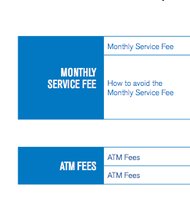 Click to enlarge. (pdf)
Click to enlarge. (pdf)
Chase has become the first big bank to voluntarily adopt a simplified, plain-language checking account disclosure, as proposed by an arm of the nonprofit group Pew Charitable Trusts.
It turns out, though, that banking disclosures can get only so simple. Chase wasn’t able to squeeze its disclosure onto a single page or box, as Pew originally proposed. Rather, its form runs three pages and has seven footnotes.
That’s because Chase chose to be comprehensive and display all potential fees, and to give examples for more complex issues, a Chase spokesman, Patrick Linehan, said in an e-mail. (The form’s third page lists 10 miscellaneous fees, like $2 for using a “counter” check, which is an “emergency” check provided when you don’t have any of your own left in your checkbook.)
Plus, Mr. Linehan said, there is some language that the bank must use for regulatory reasons but that the Pew model form didn’t take into account.
Susan K. Weinstock, director of Pew’s Safe Checking in the Electronic Age project, which worked with Chase to create its new form, said Pew had developed its model form with an emphasis on clear terms and the most common fees. But in subsequent focus groups, she said, consumers indicated they wanted details about all fees, even if it meant a longer form. Chase’s form adheres to Pew’s goal of making the disclosure shorter and simpler, she said. “The point is to make it transparent,” she said.
Even at three pages, Chase’s form is a vast improvement over the typical checking account disclosure, which a Pew study found runs about 111 jargon-filled pages.
The new form is part of a broader effort to better communicate with customers and to make sure they understand how Chase products work, said Ryan McInerney, head of consumer banking at Chase. “We want to significantly improve our customers’ experience,” he said.
Two credit unions, the North Carolina State Employees’ Credit Union and the Pentagon Federal Credit Union, have also voluntarily adopted simpler forms. (The credit unions did manage to use a one-page format).
Pew is urging the new Consumer Financial Protection Bureau to require that all banks adopt a simplified, standard form, and it has received support for its quest from some legislators.
The idea behind the new form is to make it easy for customers to see, in one place, the main features and costs of their account, so they can compare its terms with accounts at other banks, Ms. Weinstock said. While ideally the consumer protection agency would require that banks use such a form to make the disclosure standard, “We are thrilled these banks have done it,” she said. Several other smaller banks are expected to voluntarily adopt simpler forms shortly, she said.
A particularly important part of the simpler forms, she said, is an explanation of the various overdraft options available for accounts with debit cards and the costs associated with each, which can be confusing for consumers. Overdraft protection refers to the coverage of payments made when an account is overdrawn.
The forms also explain the bank’s policy governing the order in which transactions are processed. Some banks process debit transactions and checks in order of the highest amount to the lowest amount, which tends to maximize the potential for overdraft fees. Others have switched to “lowest to highest” order, or they process transactions in the order in which they occur.
Please take a look at the forms used by Chase and the credit unions and let us know if you find them helpful by posting your thoughts in the comments section.
Article source: http://feeds.nytimes.com/click.phdo?i=ee5dc4530eab73ede9d0cafddd1405eb
Speak Your Mind
You must be logged in to post a comment.